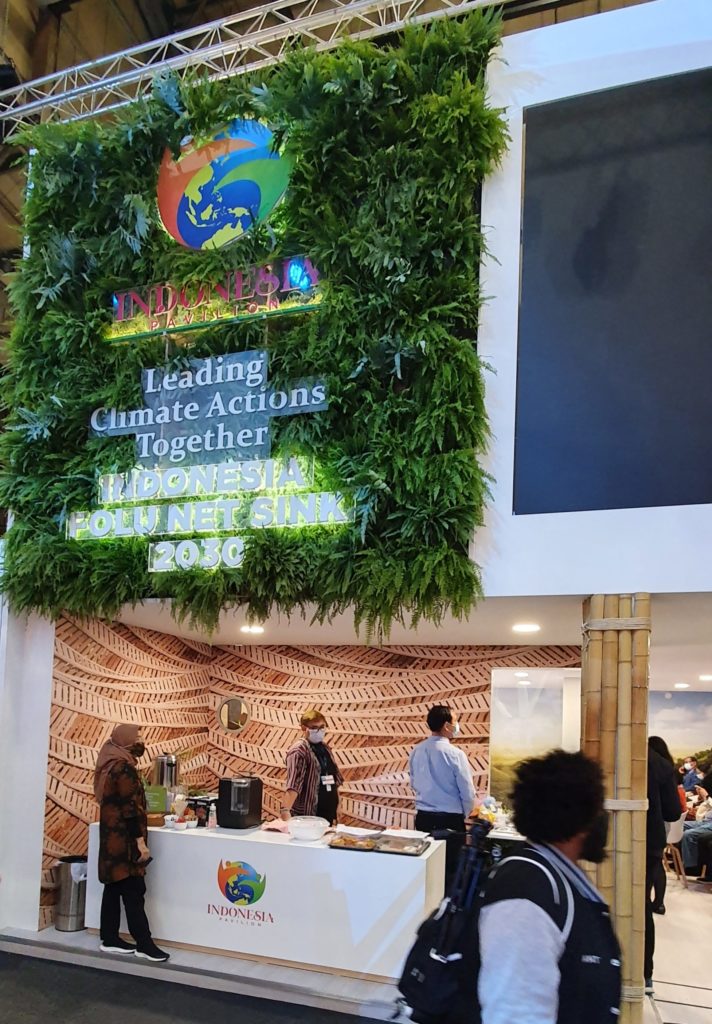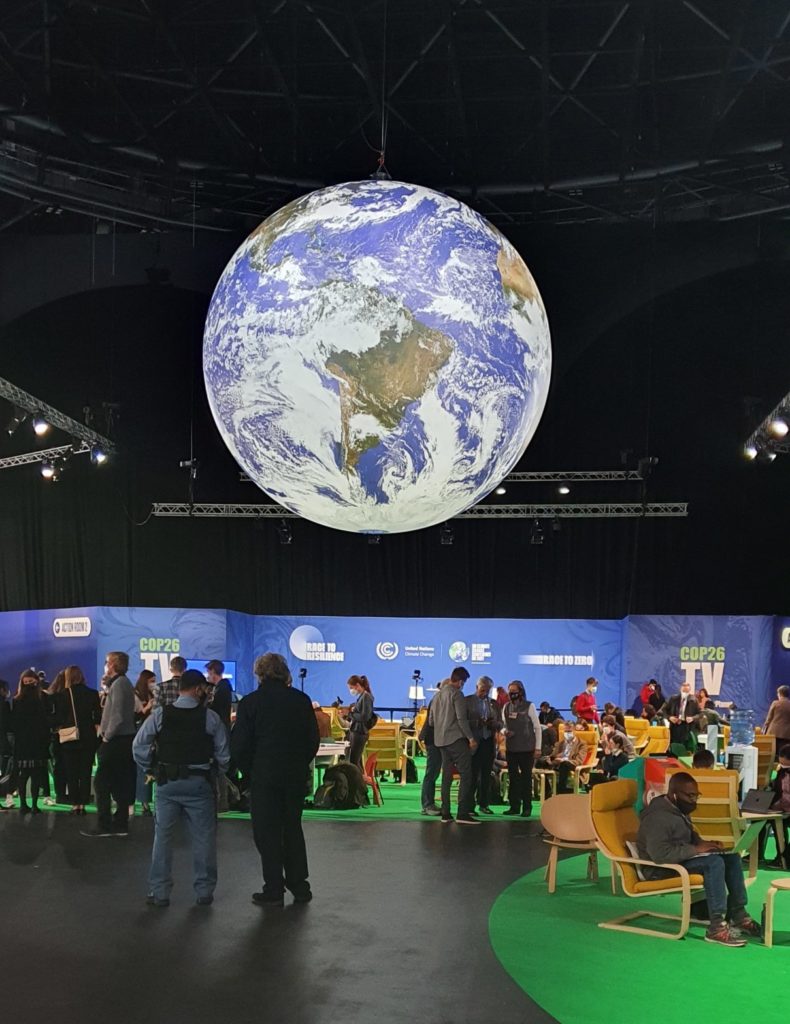by Mette M. High
As a delegate representing the University of St Andrews and the Centre for Energy Ethics, I had the opportunity to participate in the energy talks at the COP26 in Glasgow in November 2021. The summit brought together national leaders and policy makers, indigenous peoples and international organisations, researchers and advisors from around the world. With a buzzing ‘blue zone’, where talks and debates were held in countless small ‘pavilions’, it really felt like a moment in which we were “creating climate futures”, as a Kenyan speaker put it. Yet, it also highlighted the extent to which socioeconomic inequalities inform the pursuit of conflicting energy transitions, emphasising the crucial importance of developing transparent and equitable carbon accounting taxonomies.

While some pavilions were decorated as almost stereotypical tourist versions of their countries (see fig. 1 above), others seemed quasi-futuristic with lots of technical gadgets, AI and little else. In these pavilions, I was struck by how the talks and debates involved speakers not only from the host pavilion country but also from other parts of the world. I attended a panel that had speakers from Denmark and China discussing district heating systems, another panel had speakers from Uganda and Germany discussing renewable energy transitions, while a third panel had speakers from the United States and Colombia discussing energy efficient buildings. I was also at a panel with speakers from Bangladesh and Brazil discussing nature-based solutions to carbon emissions, and another with speakers from Nigeria and the Netherlands discussing de-risking investment in emerging energy markets. The speakers and the topics discussed were thus not limited to a single country or a single region, but rather explicitly opened up to the various experiences and insights from around the world. For me, this approach to knowledge sharing really captured and demonstrated the global reality of the climate challenges we are confronted with. As such, COP26 was an emphatically global conversation in how to do better for the climate.
This demonstration of globality is so important not only because of the global scale of climate change, but also because we have entered an era in which many governments, institutions and companies are making net zero carbon emissions pledges. These decarbonisation visions risk becoming inward-looking, focusing on and forefronting desired transformations within a country, within an institution or within a single company at the expense of a broader, global perspective on our collective climate predicament. While Norway may pride itself in its world-record share of electric vehicles, what about the carbon emissions involved in the mining, refining and transportation of the needed lithium, cobalt and other strategic minerals? While Drax may convert coal-fired powerplants to biomass plants in the UK, what about the carbon footprint of the timber that is procured from US forests? Confronted with global climate challenges, net zero pledges can contribute to highly local and narrow perspectives on energy transitions that celebrate achievements based on an extremely confined point system. The notion of scope 3 emissions is intended to ensure the broader systemic recognition of emissions, yet it currently remains a rather hypothetical and far from operational notion.
That inward-looking perspective was not evident at the COP26. It wasn’t just about promoting and celebrating what a given region or organisation was pledging and doing, but also about asking questions and learning from each other. By having conversations and debates that went beyond borders and confines, it was a summit that urged us to explore possibilities and limitations across continents and experiences. While we might endorse Mia Mottley’s (PM of Barbados) powerful question of “when will leaders lead?” at the COP26 opening and we might be disappointed by the COP26 outcome in the Glasgow Climate Pact, there was much more going on during the summit – beyond that document text, its enshrined future obligations and its evident loopholes.
Panellists discussed how heat from the electrolysis of water in the production of hydrogen could be channelled into heating systems, as could heat from data centres if this was considered at the stage of planning. ‘Energy cities’ could showcase energy transformations on a scale that was manageable and relatable, while creative constellations of citizen assemblies could be used effectively to ensure participation and engagement in energy transitions. Occasionally the success of these energy interventions was presented in such a way as to appear as if entirely separate and isolated from their broader socioeconomic and environmental contexts. They sounded like universal techno-fixes that could pave the way forward, whether on the African dryland or in the Arctic north, among a nomadic population or in a megacity. For me, as an anthropologist, such representations appeared as products of rather gullible and optimistic thinking. We can learn much from each other’s experiences, yet we must not lose sight of the unique complexity in which each intervention becomes a success.
Along with showcasing the globality of our energy challenges, the summit also indicated how populations and governments are differently positioned and face different issues. While a speaker from Denmark considered municipalities as key actors in leading on energy strategies, other speakers expressed discomfort with decentralising energy decisions away from national level governments. While a speaker from the International Energy Agency dismissed any significant role for fossil fuels even in the near future, other speakers emphasised that their countries depended on its hydrocarbon wealth and hadn’t yet found suitable wealth-generating alternatives. While enabling greater energy access was crucial for a delegation from Uganda, other speakers emphasised the need for lowering energy consumption. The speakers not only demonstrated global unity, but also deep local disparity. The speakers were not united in seeking the same goal. For some, energy transitions were about improving basic health and access to education. For others, it was about creating jobs and attracting growing investment. It was clear that ‘energy transitions’ were plural, multifaceted and not necessarily mutually aligned. Long-standing socioeconomic inequalities are part and parcel of the pursuit of conflicting energy transitions, as was powerfully voiced by many politicians of the Global South.

At a time of high climate ambitions and multiple energy transitions, it will be important to have a shared currency underpinning and guiding our changing energy practices. As we innovate, transform and optimise our energy practices in diverse ways, how to ensure ‘we create the change that the world needs?’ as a speaker put it. Throughout the talks and debates I attended, I observed how speakers repeatedly put forward ‘carbon emissions’ as precisely that shared currency. It was used as a store of value in discussions of capital markets and investment decisions, supply chains and labour markets, community participation and energy inequities. It appeared as a medium of exchange in discussions of avoided emissions, divestments, offsetting, and carbon capture and storage technologies. And with calls for a carbon tax, it emerged as a unit of account that could connect emitters across the world through transactional relationships. Currently carbon accounting takes many different shapes and doesn’t amount to a single global, or even regional, standard. As such, its development will be crucial for our future and for the meanings of ‘net zero’. As scholars of accounting have reminded us, accounting is fundamentally about what we value and how we value. It is a translation of ethics that renders our values comparable and operational. In my view, the development of broader taxonomies of carbon accounting is thus the frontline of energy transitions. These taxonomies will indicate how we value lives and livelihoods globally. Attending closely to the development of these principles far beyond the COP26 will be crucial as they will affect how we spend our truly global, collectively shared, climate currency.




